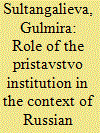| Srl | Item |
| 1 |
ID:
128698


|
|
|
|
|
| Publication |
2014.
|
| Summary/Abstract |
The institution of pristavstvo was introduced in the Kazakh Steppe in the first decade of the nineteenth century. This institution had different meanings and functions, from an individually held position (e.g., a pristav to the kh?n of the Junior Horde in 1820; the pristavs who accompanied the Kazakh delegation to Saint Petersburg in the first half of the nineteenth century) to an administrative-territorial structure (e.g., the pristavstvo of the Senior Horde; the Mangyshlak and Zaisan pristavstvos). Though the political structure of the Russian empire had included institutions analogous to the pristavstvo, it was not a conventional component of the Russian administrative system. Studying the features of the pristavstvo institution in the territory of Kazakhstan and analysing the transformation of the pristav's function provide new insights on how the multi-ethnic Russian empire was managed. They will also help scholars to better understand the forms and methods the Russian authorities employed to manage their nomadic populations.
|
|
|
|
|
|
|
|
|
|
|
|
|
|
|
|
| 2 |
ID:
171132


|
|
|
|
|
| Summary/Abstract |
This article studies an early-twentieth-century reform in local administration on the Kazakh Steppe. It was catalyzed by the massive in-migration of peasant settlers from European Russia, which required fundamentally new administrative forms and institutional decisions from the state. In 1902 the Russian Empire extended the Temporary Regulation on Peasant Nachalniks, which was previously law only in Siberia, to the steppe oblasts of Akmola, Turgai, Semipalatinsk and Uralsk. In examining discussions surrounding the implementation of the new law, this article uncovers the complexity and ambiguities of the decisions that were made, the problems the new law faced, and the wide array of participants in enacting it. The article also compiles a socio-cultural portrait of the peasant nachalniks and the activities they undertook. Finally, it addresses how the Kazakh population perceived these new officials, and how they interacted with representatives of the Kazakh administration, which was crucial to their effectiveness.
|
|
|
|
|
|
|
|
|
|
|
|
|
|
|
|